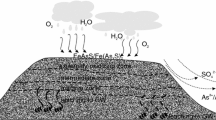Abstract.
The Carnoulès Pb mine closed 40 years ago, leaving tailings (pyrite-rich silts) exposed. In 1982, the tailings were gathered and placed behind a concrete dam, above a drainage pipe, and then covered with a clay layer. The As-rich pyrite in the tailings has oxidized; acidic water with high As concentrations (100–350 mg/L As) now emerges from the base of the dam. Strikingly, there is no oxidation zone at the surface of the tailings. The clay cover and the low hydraulic conductivity of most of the tailings (10−7 m/s) strongly limit rainwater infiltration. Water table variations, water balance calculations, and flow modelling indicate subsurface water input and water flow along the bedrock within a more permeable sandy horizon. This lower horizon is strongly oxidized due to this flow pattern. The As-rich water is mainly produced in the northern part of the tailings area, where seasonal variations in the water table (a succession of aerobic/anaerobic periods) are important. This water flows through a drainage pipe to an acidic spring.
The disposal of tailings can release acidic and toxic waters into the environment. Monitoring and modelling of such tailings allow one to define the potential impact and propose remedies.
Similar content being viewed by others
Author information
Authors and Affiliations
Rights and permissions
About this article
Cite this article
Koffi, K., Leblanc, M., Jourde, H. et al. Reverse Oxidation Zoning in Mine Tailings Generating Arsenic-rich Acidic Waters (Carnoulès, France). Mine Water and the Environment 22, 7–14 (2003). https://doi.org/10.1007/s102300300002
Issue Date:
DOI: https://doi.org/10.1007/s102300300002




